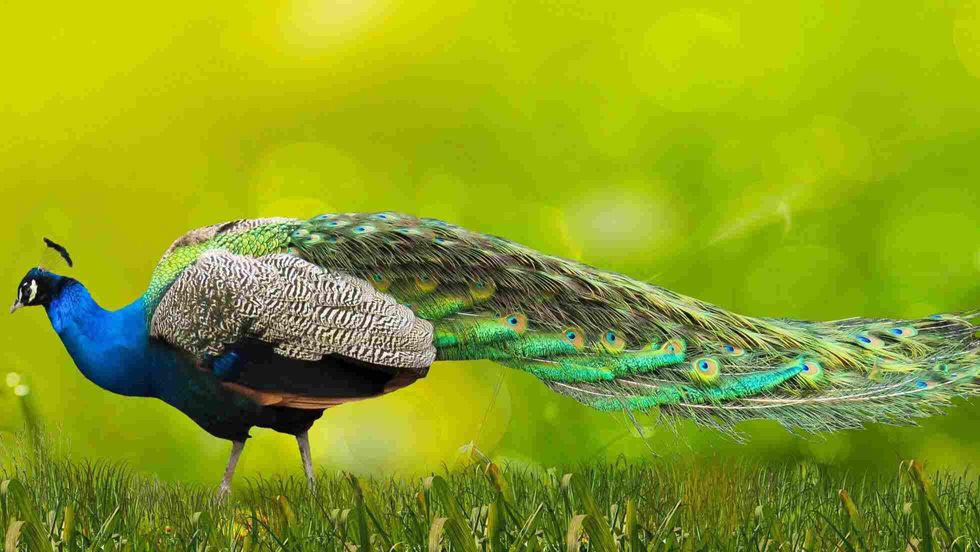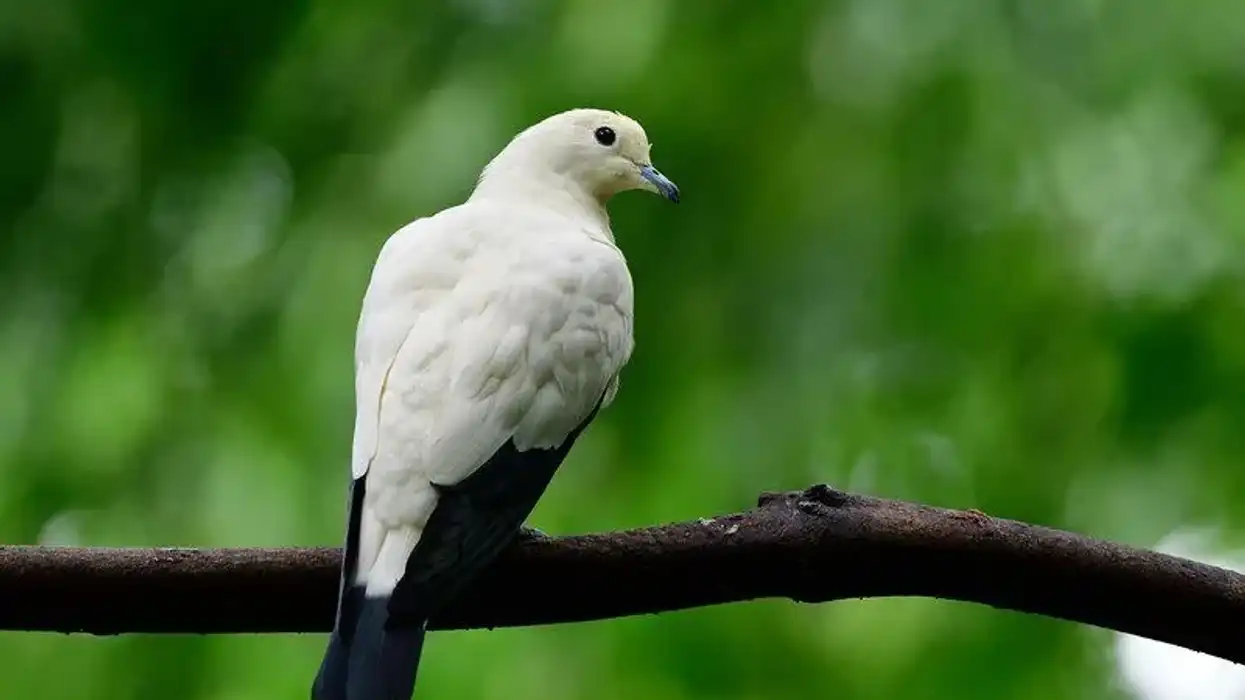Congo peafowl (Afropavo congensis) is called the African peafowl or mbulu. This species belongs to the genus Afropavo. Congopeacocks are a link between the two families, peafowl and guinea fowl.
Antwerp Zoo in the Democratic Republic of the Congo set up a breeding program for Congo peafowls. Among the thousands of peafowl species, a Congo peafowl is a sight to behold. Female peahens' feathers are brown and green to allow them to camouflage with the rainforest floor.
Male and female Congo peafowl (Afropavo congensis) do not display sexual dimorphism like the Indian and green peafowl. Have a look at peafowls’ interesting facts and get to know more. Afterwards, do check our other fact files on the Indian peafowl and the green peafowl.
Congo Peafowl Interesting Facts
What type of animal is a Congo peafowl?
Congo peafowl (Afropavo congensis) is a bird. It is a colorful, friendly, and territorial bird living in the lowlands. Habitat loss has pushed this beautiful bird species towards the status of Vulnerable in the IUCN Red List, necessitating conservation efforts.
What class of animal does a Congo peafowl belong to?
Congo peafowl (Afropavo congensis) belongs to the bird class of animals. It is amongst one of the three peafowl classes in the world.
How many Congo peafowls are there in the world?
There are 2,500-9,000 Congo peacocks in the world. Their decreasing population due to habitat loss has become a major concern for their species. That is why a zoo called the Antwerp Zoo set up a breeding program for them.
Where does a Congo peafowl live?
Congo peafowl of the genus Afropavo lives in the woods. These native African species prefer forests and vegetation with small heights. As this species is facing the threat of extinction, they can now be found in various zoos across the world.
What is a Congo peafowl's habitat?
Congo peafowls live in forest lowlands, low hills, watersheds. Peafowls are most commonly found near water sources; this is to fulfill their food and water requirements at the same time. They prefer small trees and small plants for their habitat.
Who do Congo peafowls live with?
Congo peafowls live with the peafowls of their species. They are found in pairs as well as packs. Sometimes they are even found living near human settlements.
How long does a Congo peafowl live?
Congo peacocks have a lifespan of 10-25 years. The lifespan in captivity is slightly higher than that in the wild. They live much longer than many birds of their size. Indian peacocks as well as various other subspecies of peahens have a similar life expectancy. However, many subspecies of peacocks have an average lifespan of 40-50 years.
How do they reproduce?
Congo peacocks fan their tail feathers to attract females. Food is given to the prospective mate by the Congo peacock. Congo peacocks are monogamous birds.
Breeding occurs two to three times every year and they follow the process of sexual mating. After the mating process is completed, females dig holes in the ground to lay their eggs. The average clutch size ranges between four to six eggs.
Congo peacock eggs take around 28 days to be incubated. Both male and female Congo peacocks take care of their chicks after they hatch from the eggs. The fledging period for Congo peacock chicks is one month.
What is their conservation status?
The conservation status of Congo peafowl has been listed as Vulnerable by the IUCN. Their population has been severely decreasing as an effect of mining, logging, and shifting cultivation which in turn has resulted in the problem of habitat loss. The breeding program of Antwerp Zoo is greatly helping in their conservation.
Congo Peafowl Fun Facts
What do Congo peafowls look like?
Male Congo peafowl has deep blue, metallic green plumage with a violet tinge. Females have chestnut brown feathers. They have a black abdomen and small chestnut-brown chest. Males have a bare redneck and a tail with 14 black tail feathers.
Their feet are gray in color. They have a crest with white elongated feathers. They have similar green, metallic green colors of Indian peacocks.
How cute are they?
Congo peafowl is a very cute bird. They are colorful and a person can admire their beauty for a very long time.
How do they communicate?
Congo peafowls fan their tail feathers in order to establish communication. Their vocals are loud. Males call 'gowe' while females call 'gowah'. Besides that, both males and females of the species use 'rro-ho-ho-o-a' to debate among themselves.
How big is a Congo peafowl?
Congo Peacock is 25-28 in (63.5-71 cm) in length while peahens are 24-25 in (60.9-63.5 cm) long. The height of Congo peacocks ranges between 23-27 in (58-68.5 cm). These birds are five times bigger than a cat.
How fast can a Congo peafowl move?
Congo peafowls can move as fast as 10 mph (16 kph). They are pretty fast considering their body weight and long feathers.
How much does a Congo peafowl weigh?
Congo peafowl on average weighs between 6-13 lb (2.7-5.8 kg). The bodyweight of this species of peafowl is greater than most bird species.
What are the male and female names of the species?
Male Congo peafowls are called Congo peacocks and female Congo peafowls are called Congo peahens.
What would you call a baby Congo peafowl?
A baby Congo peafowl is called a chick. Sometimes they are also referred to as juveniles.
What do they eat?
Congo peafowls diet mainly comprises insects and fruits. Their insectivorous diet includes spiders, mollusks, worms. While their herbivorous diet consists of Allanblackia floribunda, and Canarium schweinfurthii.
Are they aggressive?
Congo peafowls can get very aggressive over food and territory. They don't like when someone takes their food and can attack the person or animal responsible. They use their beak to poke their prey.
Would they make a good pet?
Congo peafowls are not suitable to be kept as pets in the majority of households even though they have very basic food requirements and need little to no grooming. They are vulnerable animals so should not be kept as pets.
Did you know...
The Congo peafowl is entitled as the national bird of the Democratic Republic of the Congo.
The Congo peacock bird species is native to Africa.
Can Congo peafowls be friendly?
Congo peafowls are friendly only if you do not mess with them. They are known to not harm any humans unless provoked.
Can Congo peafowls fly?
Congo peafowls cannot fly. This species takes short flights from branch to branch on trees. Even though they have long tail feathers, their body is not suitable for flying.
Here at Kidadl, we have carefully created lots of interesting family-friendly animal facts for everyone to discover! For more relatable content, check out these song thrush facts and marbled murrelet facts pages.
You can even occupy yourself at home by coloring in one of our Congo Peafowl coloring pages.










